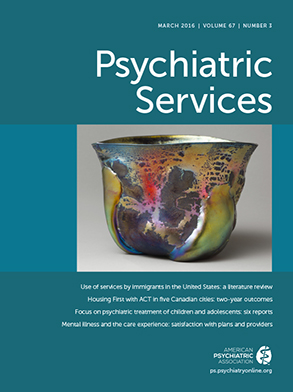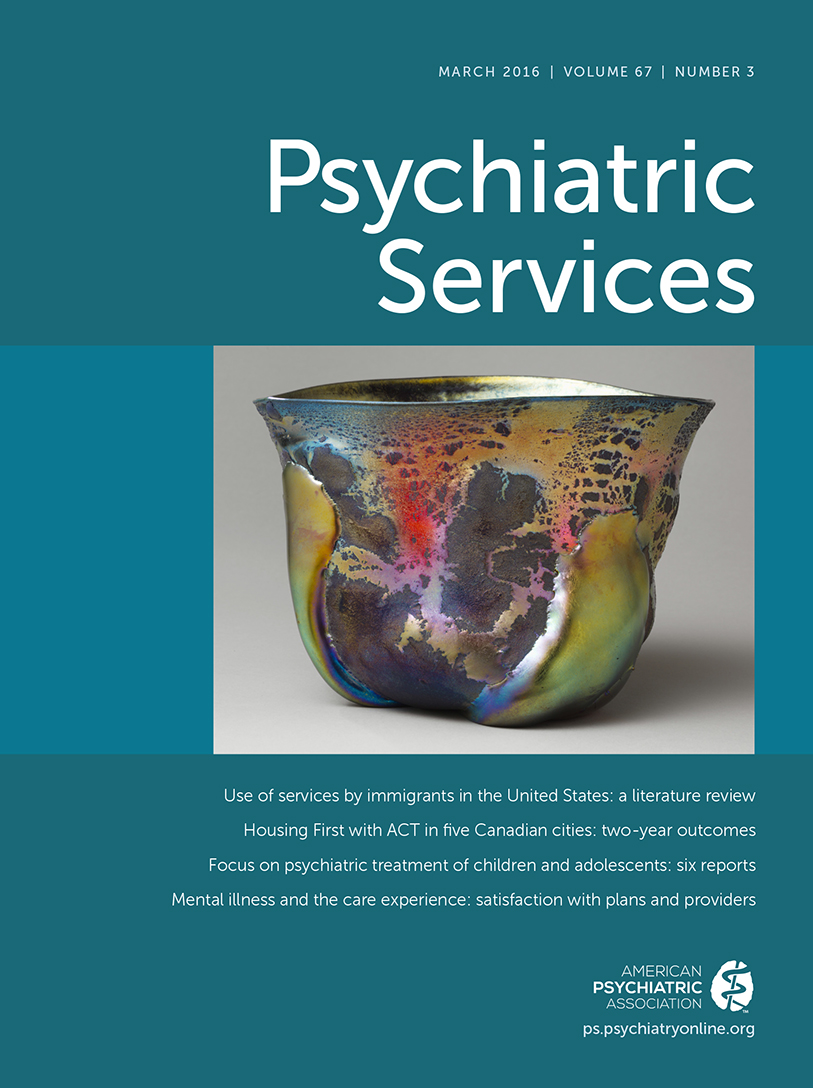Powerful antipsychotic medications have been increasingly prescribed to children in the United States over the past 15 years (
1,
2), and the rate continues to increase for adolescents (
3). We argue that because children are especially vulnerable to known and potential harms from antipsychotics, alternative therapies that are also efficacious but safer should be considered first. We recommend several steps to improve mental health services and protect children who might receive antipsychotic medications.
Uses and Efficacy of Antipsychotics for Children
The U.S. Food and Drug Administration has approved the use of antipsychotics as first-line treatments for children with schizophrenia, bipolar disorder, and severe behavioral problems associated with autism, such as aggression, tantrums, and self-injury. In practice, however, antipsychotics for children are predominantly used off label. In 2009, the most common diagnosis among children and adolescents receiving antipsychotics was attention-deficit hyperactivity disorder (ADHD), although bipolar disorder, unipolar depression, autism spectrum disorders, and other developmental disorders were also common (
3). Prescriptions to children of second-generation antipsychotics in particular have risen dramatically over the past 15 years (
1,
2), typically for nonpsychotic conditions. Although prescriptions for younger children may have leveled off by 2010, prescriptions for adolescents continued to rise (
3). The most vulnerable children—those in foster care, the juvenile justice system, and institutions—have been the most likely to receive antipsychotics (
4).
Several randomized controlled trials have demonstrated that antipsychotics are efficacious compared with placebo for children with various conditions, such as bipolar manic symptoms, self-injurious and disruptive behaviors in autism spectrum disorders, and aggressive behaviors in general (
5). Most of the controlled studies of these medications have, however, been brief, and many have been sponsored by industry.
Risks of Antipsychotic Use by Children
Data on the side effects of antipsychotic use by children have come largely from short-term studies. As detailed in more comprehensive reviews, side effects have varied depending on the specific medication and its mechanisms of action (
5,
6). Potential side effects have included somnolence-sedation, gastrointestinal complaints, and excessive weight gain. Other side effects among children have included symptoms linked with metabolic syndrome (hyperglycemia, abnormal lipid levels, hypertension, and insulin resistance) and hormonal effects (hyperprolactinemia, abnormal breast development, galactorrhea, and amenorrhea). Children have had proportionately greater and more rapid weight gain and more adverse hormonal effects than adults (
7). Although less common with second-generation antipsychotics than with the first-generation agents, neurological effects have also been reported: muscle rigidity (dystonia), Parkinson’s syndrome, and restlessness (akathisia), as well as potentially irreversible movement disorders (tardive dyskinesia). Neuroleptic malignant syndrome has been rare, but it is potentially fatal. Cardiovascular effects, such as tachycardia and prolonged QTc interval, have also been reported. Longitudinal follow-up studies have not been conducted with larger samples to assess the long-term risk of these and other acute side effects. Furthermore, although guidelines have recommended regular physical exams and laboratory tests to monitor for metabolic and neurological side effects (
8), poor compliance with such monitoring guidelines for children has been another significant concern (
9,
10).
Some of the more serious side effects take longer to emerge and may persist beyond the duration of medication use. The long-term metabolic effects among children, either with continued use or after discontinuation, are largely unknown, but antipsychotic use by young adults has led to obesity, diabetes, and heart disease (
7). Long-term effects on children’s social functioning are also unknown, but cumulative exposure to antipsychotics has recently been linked to decreases in social functioning among young adults (
11) and to progressive neurotoxicity (cortical thinning) among adults (
12). The longitudinal effects of antipsychotics on brain development in animal models have also suggested concerns regarding safety (
13). Yet long-term neurodevelopmental and other side effects have not been studied among children.
Alternative Therapies
Although few studies of children have directly compared the effects of other therapies with antipsychotics, several studies have shown that alternative pharmacological and psychosocial interventions are efficacious, with effect sizes similar to those reported for antipsychotics. For example, a recent trial demonstrated that children with ADHD and aggression refractory to either a methylphenidate or an amphetamine stimulant often responded well when a stimulant from the other stimulant group was systematically titrated upward to clinical response and combined with behavioral therapy (
14). Moreover, several nonstimulant medications are now approved for ADHD, including atomoxetine and extended-release formulations of guanfacine and clonidine. Guanfacine and clonidine have also been labeled as adjunctive treatments for ADHD patients partially responsive to a stimulant. Apart from antipsychotics, other medications, including lithium and divalproex sodium, are approved and used for pediatric bipolar disorder, but their use requires laboratory and clinical monitoring for worrisome side effects, such as hypothyroidism or renal failure in the case of lithium or blood dyscrasias and polycystic ovarian disease in the case of divalproex sodium (
15).
For children with disruptive behaviors and aggression, short-term psychosocial interventions involving manualized parent training (for example, parent-child interaction therapy and parent training management–Oregon model), cognitive-behavioral techniques (for example, problem-solving skills therapy), or, for adolescents, multifocused interventions (for example, multisystemic therapy) have well-established effects that rival those of pharmacological treatment (
16). Many psychosocial interventions are efficacious for disruptive behaviors and aggression among patients with autism spectrum disorders (
17). On the basis of the available evidence, a work group of the American Academy of Child and Adolescent Psychiatry has recommended psychosocial rather than pharmacological interventions as the first-line treatment for children with aggressive behaviors (
18).
Discussion
The crux of the issue is this: Children in the United States have increasingly been prescribed antipsychotic medications despite potentially serious short- and long-term side effects. Yet other efficacious and safer interventions are available. Several factors may have contributed to the overuse of antipsychotics for children: intense and inappropriate advertising (several companies have reached multibillion dollar settlements with the Department of Justice related to false advertising); expansion among children of the diagnoses of bipolar disorder, autism, and other conditions; increasing difficulties obtaining inpatient hospitalization and evidence-based psychosocial treatments; lack of education and shared decision making; prescribers’ and guardians’ willingness to control behavior quickly despite potential side effects; and lack of access to qualified mental health professionals who can deliver other evidence-based interventions to children with problematic behaviors (
7,
9,
19).
We should be concerned about overuse of antipsychotics for many reasons. Children are inherently vulnerable because their brains and bodies are still developing and may be permanently altered by powerful medications. Their disruptive behaviors are often related to disruptive parenting and stressful environments, which deserve primary attention. Adults may be motivated by the desire to achieve short-term control of behavior rather than to enhance children’s long-term growth and development. Children with mental illness are affected by high rates of economic disadvantage, stigma, and inaccurate attributions (for example, family problems labeled as the child’s behavior problems). The most vulnerable children—those with absent or tenuous caregiver advocacy, such as children in foster care, the juvenile justice system, or institutions—are the most likely to receive antipsychotics. Children often have difficulty describing their thoughts and feelings (for example, children with developmental disabilities or autism), and antipsychotics can further interfere with their expression of physical and emotional sensations and needs.
All of the above concerns have profound implications for mental health services. We suggest several steps. First, emphasize prevention. Other wealthy countries provide for extended maternal leave and family supports. Children receiving antipsychotics often come from situations of family disruption, neglect, trauma, abuse, changes in parenting and guardianship, poverty, environmental exposure to toxins, and other stressors. These socioenvironmental problems can be addressed by established strategies of prevention and early intervention that would preclude the need for medications. Second, educate and prepare the workforce. Many professionals are unaware of safer, evidence-based interventions or are unable to provide such interventions. Training must include educating prescribers to use safer medication strategies and educating psychotherapists to use evidence-based interventions for disruptive behaviors. Third, use guidelines to monitor prescribers’ clinical behaviors and improve compliance. Training prescribers is essential, but they often do not comply with such guidelines even when they are aware of them. Noncompliance suggests a need for closer monitoring and feedback, prior authorization, and other quality improvement strategies (
20).
Fourth, clinicians, parents, and guardians need better information about antipsychotics and greater involvement in shared decision making. The development of decision aids may help to educate stakeholders, promote more in-depth discussions of potential benefits and harms, and improve the decisions made regarding care. Fifth, the courts, state agencies, school health officials, foster care and residential workers, and others charged with protecting vulnerable children need systematic education about these issues. Decisions should not rest with public officials uninformed about the dangers of antipsychotics and unaware of the availability of safer alternatives.
Conclusions
Increasing evidence suggests that antipsychotic medications have potentially dangerous side effects. Antipsychotics have serious short-term side effects among children, and more extended, longitudinal data on their safety in this particularly vulnerable age group do not exist. Clearly, the National Institutes of Health, private foundations, and the pharmaceutical industry should prioritize studies of the longer-term clinical and developmental effects of antipsychotic use by children. They should also support research on potentially safer pharmacological and psychosocial interventions for disruptive behavior and emotional disorders of children. Health professionals, researchers, families, and legal guardians must protect children. Clinicians have an ethical obligation to provide evidence-based treatment—but also to do no harm.

